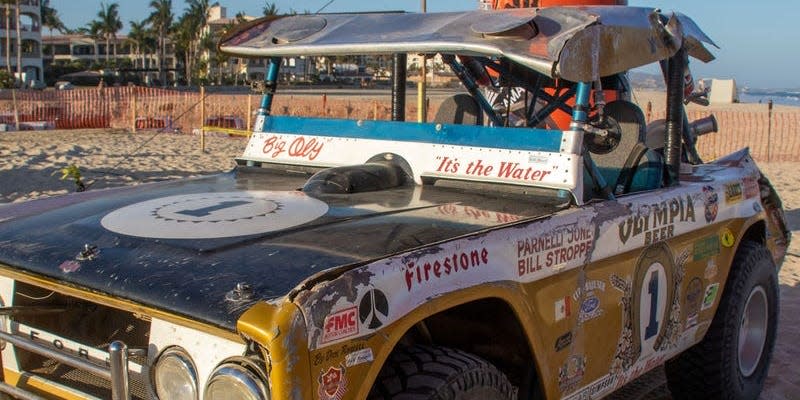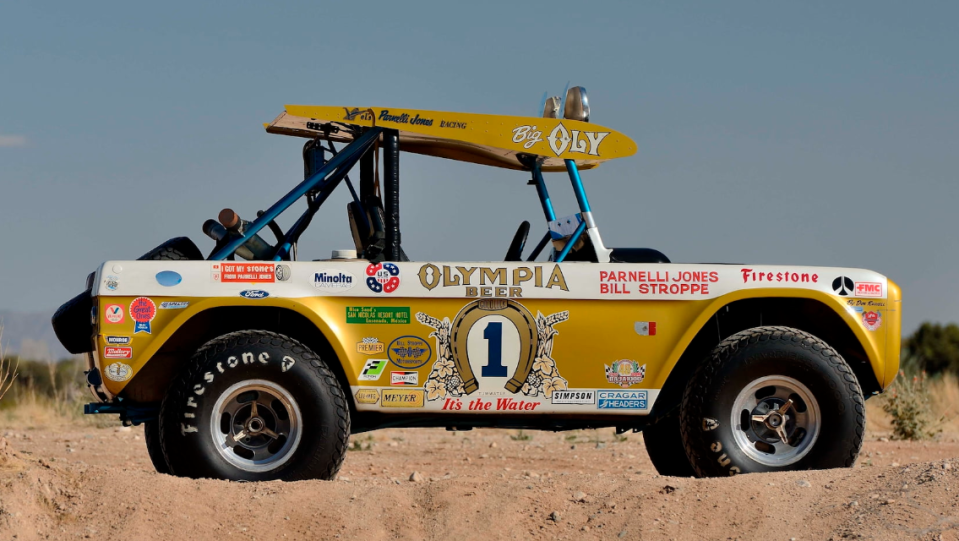No, You Couldn’t Have Driven the Oly Bronco Any Better

The iconic Oly Bronco, raced to victory in two Baja 1000s by Parnelli Jones, was rolled twice in the recent NORRA Mexican 1000.
Big Oly has always been notoriously difficult to keep upright, even Parnelli Jones rolled it numerous times while racing.
The drivers this time were Meyers Manx' new owner Phillip Sarofim and Mark Porsche, great grandson of Ferdinand Porsche.
As you may have heard, the great icon of an off-road racer the Oly Bronco rolled over last week when it was in the NORRA Mexican 1000. Actually it rolled twice, with two different drivers. No one was hurt and the tubeframe chassis appears to have survived intact. The only damage was to the rear end bodywork and the big wing that served as a roof.
Since the accident, there have been many commenters who have said something to the effect of, “If I’da’ been drivin’ that sucker it would nevera’ rolled, I’ll tell you that!” Fact is, even the great Parnelli Jones rolled it back when he was racing it to victory in two Baja 1000s.
The problem is the basic dimensions of the big brute. And its rear differential—or lack thereof. The Bronco was thought up by racing legend Parnelli Jones and designed by him and fabricator Dick Russell. Earlier Broncos Jones had tried off-road were four-wheel drive and heavy. They were also based on production frames. Parnelli wanted a tube frame with a fiberglass body. Along with master fabricator Russell, Parnelli drew it out on a napkin, according to longtime Vel’s Parnelli Jones team member Jim Dilamarter. The resulting car was built at Bill Stroppe’s shop and driven by Jones—with Stroppe in the passenger seat yelling for him to slow down—to two wins in the Baja 1000, 1971 and 1972. The off-road racing world was never the same after that and you can trace the lineage of today’s million-dollar Trophy Trucks to the Big Oly Bronco.
The famous rig has always had some design shortcomings that made it a real handful to drive, however. To find out more, we called up Dilamarter himself and asked him what Big Oly was like to drive.
“The Bronco has several things that kind of would contribute to the flip,” Dilamarter said. “One: it’s a short wheelbase, two, it’s a narrow track, three, it has a high center of gravity, and four, it has a spool rear end. Those are the things that contribute to that. Plus, you know, over exuberance, whatever.”

Those in touch with rear end componentry, so to speak, know that a spool rear end differs from an open rear differential, limited-slip diff, and locking diff in that it’s just a 90-degree bend for the torque to go from the driveshaft and through before going to each rear wheel equally.
“For a dedicated drag car that goes in a straight line, it’s pretty much a no-brainer that a spool is the way to go,” says the spool page at Mark Williams Enterprises, which specializes in axles and other parts for drag racing. “With torque applied equally to both rear wheels, it makes for optimum acceleration potential. Of course, with both rear wheels ‘locked’ in unison, when it comes time to make a turn the rear end is ‘fighting’ it, as opposed to a car equipped with a differential that allows the outboard wheel to rotate slightly more than the inboard wheel and go through an arc smoothly.”
“Spools are all about getting full lockup on a budget… 100% lockup 100% of the time,” says Yukon Gear and Axle’s page. “There are two types of spools: full spools and mini spools. Each attains the same objective, ensuring both drive wheels on a given axle receive full torque and rotate at the same speed all the time. They create a solid axle.”
Back to Dilamarter: “So when you have a spool rear end, obviously, if you’re turning left, the left wheel turns just as much as the right turns. So if you try to make a sharp turn you’re gonna flip, it’s just automatic.”

 Yahoo Autos
Yahoo Autos 